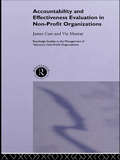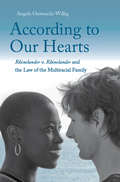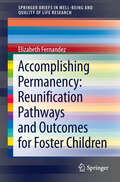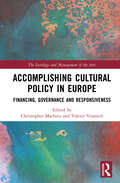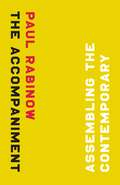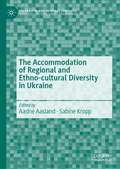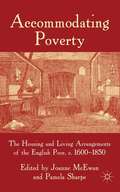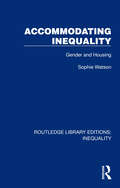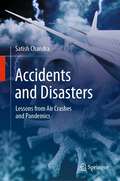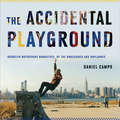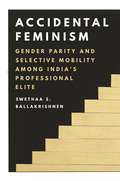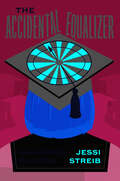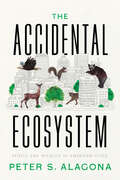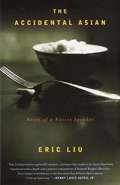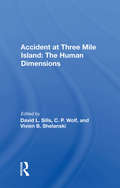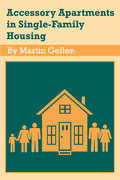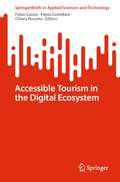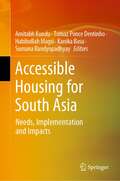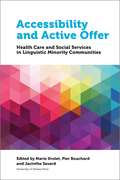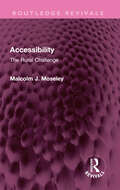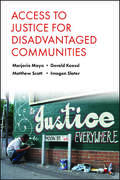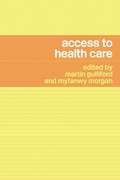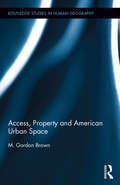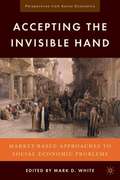- Table View
- List View
Accountability and Effectiveness Evaluation in Nonprofit Organizations (Routledge Studies In The Management Of Voluntary And Non-profit Organizations Ser. #Vol. 4)
by James Cutt Vic MurrayThis unique volume provides new perspectives on assessing the performance of nonprofit organizations whilst meeting the information needs of decision-makers, both internal (such as resource-providers, regulators and clients), and external (including boards, managers, staff and volunteers).Whilst most discussions of accountability focus exclusively
According to Our Hearts
by Angela Onwuachi-WilligThis landmark book looks at what it means to be a multiracial couple in the United States today. According to Our Hearts begins with a look back at a 1925 case in which a two-month marriage ends with a man suing his wife for misrepresentation of her race, and shows how our society has yet to come to terms with interracial marriage. Angela Onwuachi-Willig examines the issue by drawing from a variety of sources, including her own experiences. She argues that housing law, family law, and employment law fail, in important ways, to protect multiracial couples. In a society in which marriage is used to give, withhold, and take away status--in the workplace and elsewhere--she says interracial couples are at a disadvantage, which is only exacerbated by current law.
Accomplishing Permanency: Reunification Pathways And Outcomes For Foster Children (SpringerBriefs in Well-Being and Quality of Life Research #7)
by Elizabeth FernandezReunification is a primary goal of foster care systems and the most common permanency planning decision. It is defined as the return of children placed in protective care to the home of their birth family and used to describe the act of restoring a child in out-of-home care back to the biological family. Yet reunification decision-making and the process of reintegrating children into birth families remains under researched. This Brief takes a look at family reunification knowledge and research in Australia where there is evidence that most children placed in protective care are eventually reunited with their birth parents. It explores how a knowledge of reunification decision making and outcomes can contribute to strengthening practice and informing policy formulation and program planning in Child Welfare.
Accomplishing Cultural Policy in Europe: Financing, Governance and Responsiveness (The Sociology and Management of the Arts)
by Christopher Mathieu Valerie VisanichThis book investigates the activities undertaken by the variety of actors that contribute to accomplishing cultural policy in Europe. These range from policy formulation and administration at the national and local levels, to artistic and cultural production activities to institutional governance. Arts and culture are an essential component to individual and collective quality of life. States, regions and municipalities increasingly recognize this intrinsic importance, as well as the instrumental values of the arts and culture. This has led to an increased interest in cultural policy, usually focusing on the policy process and policy effects. How cultural policy is accomplished is a matter of correspondingly increased importance, but less researched and understood. This volume shows how accomplishing cultural policy encompasses a vast expanse of activities, all unique but bound together as part of the continuous process of producing publicly subsidized art and culture for social and aesthetic purposes. The chapters also explore a range of thematic tensions that commonly arise in accomplishing cultural policy, such as the commercialization of arts and culture and counter-reactions; the challenges and means of promoting inclusiveness; the politics and effects of funding of the arts and culture; and good governance and vested interests in the arts and culture. Read together, these vivid case studies present a broad and unique picture of the wider and interconnected accomplishing process by expounding on the middle-ground between the policy formulation process and artistic and cultural production. Adding a novel conceptual formulation to studies of cultural policy, this book will appeal to practitioners, scholars and advanced students with interests in the sociology of the arts and culture, arts and culture management, cultural policy and cultural governance.
The Accompaniment: Assembling the Contemporary
by Paul RabinowIn this culmination of his search for anthropological concepts and practices appropriate to the twenty-first century, Paul Rabinow contends that to make sense of the contemporary anthropologists must invent new forms of inquiry. He begins with an extended rumination on what he gained from two of his formative mentors: Michel Foucault and Clifford Geertz. Reflecting on their lives as teachers and thinkers, as well as human beings, he poses questions about their critical limitations, unfulfilled hopes, and the lessons he learned from and with them. This spirit of collaboration animates The Accompaniment, as Rabinow assesses the last ten years of his career, largely spent engaging in a series of intensive experiments in collaborative research and often focused on cutting-edge work in synthetic biology. He candidly details the successes and failures of shifting his teaching practice away from individual projects, placing greater emphasis on participation over observation in research, and designing and using websites as a venue for collaboration. Analyzing these endeavors alongside his efforts to apply an anthropological lens to the natural sciences, Rabinow lays the foundation for an ethically grounded anthropology ready and able to face the challenges of our contemporary world.
The Accommodation of Regional and Ethno-cultural Diversity in Ukraine (Federalism and Internal Conflicts)
by Aadne Aasland Sabine KroppThe book offers new insights into how ethnicity, language and regional-local identity interact within the context of Ukrainian political reform, and indicates how these reforms affect social cohesion among ethno-cultural groups. While the individual chapters each focus on one or a few facets of the overall research question, together they draw a nuanced picture of the multifaceted challenges to creating and consolidating social cohesion in a nationalizing state. The concept integrates various disciplines, including political science, international relations, law, and sociology. Correspondingly, the contributions are based on various methodological approaches, ranging from legal analysis over media discourse analysis, individual and focus group interviews to analysis of data from a representative population survey. The findings of the in-depth study are discussed within the broader context of comparative research on diversity management and social cohesion in fragmented societies.
Accommodating Poverty
by Joanne Mcewan Pamela SharpeThis book offers a detailed examination of the living arrangements and material circumstances of the poor betweeen 1650 and 1850. Chapters investigate poor households in urban, rural and metropolitan contexts, and contribute to wider investigations into British economic and social conditions in the long Eighteenth century.
Accommodating Inequality: Gender and Housing (Routledge Library Editions: Inequality #9)
by Sophie WatsonOriginally published in 1988, Accommodating Inequality provides a basis for a radical re-think of housing policy and provision in Australia from a gender perspective. It explores the way that housing in Australia helped to produce patriarchal family structures and simultaneously contributed to the dependence of women on men. At the time the book was originally published housing policy at a theoretical or research level was less explored. Issues such as marginalisation, poverty and low income, domestic responsibility are discussed in relation to housing. The book raised new questions and challenged old debates and provides a clear framework within which feminist housing policy can be situated.
Accidents and Disasters: Lessons from Air Crashes and Pandemics
by Satish ChandraThis book deals with the contemporary subject of perception of risk and its influence on accidents and disasters. The contents examine the conventional viewpoints on human errors, incubation of errors, complexity and organisational deviance as a cause for accidents. Work of Mary Douglas with regard to risk, Charles Perrow's work on the normal accident theory and Diane Vaughn's theory on normalisation of deviance are examined from a fresh perspective in this book. It also discusses prominent accidents in aviation, space, nuclear energy, automotive and healthcare, using the pandemic and Boeing 737 Max as a backdrop to study accidents and disasters. It further explores the background and similarities to these events and addresses the core issues such as the state of regulation, the worldview of the sociologists, and proposes that mental models of complex systems, avarice and risk for gain as other possibilities for accidents. Using the concept of nudge in behavioural economics and the Elinor Ostrom’s viewpoint on regulating for common good, it suggests a way forward through the High Reliability Organisation Theory (HRO) leading to enhanced risk perception. The book will be of interest to those who would like to understand the need to incorporate risk perception into regulation, engineers and scientists, professionals and policy makers working in the areas of disaster and risk management, technology areas like aviation, nuclear plants, space and healthcare, students of the sociology of risk and of course the general reader.
Accidental Wilderness: The Origins and Ecology of Toronto’s Tommy Thompson Park
by Walter H. KehmOnce referred to as Toronto’s “accidental wilderness,” Tommy Thompson Park is now recognized as a fortuitous urban miracle. Initially created as a landfill site on the city’s rapidly developing waterfront, the park’s physical and ecological footprint have grown dramatically. Forests, grasslands, and wildlife now thrive – all within a stone’s throw of some of the most densely populated areas of North America’s fourth-largest city. Accidental Wilderness is a rich and lyrical collection of essays curated by internationally recognized landscape architect and original designer of Tommy Thompson Park, Walter H. Kehm, complemented by a stunning collection of photographs by renowned landscape photographer Robert Burley. The book explores the city’s port origins; the park’s master plan principles and design; the native-plant succession process; the park’s unique flora and fauna; public advocacy; and public recreation in the park and its effect on mental, physical, and spiritual health. In an era where the looming dangers associated with climate change affect our daily lives, Tommy Thompson Park offers a hopeful narrative about how nature can flourish in, and contribute to, the well-being of twenty-first-century cities.
The Accidental Playground: Brooklyn Waterfront Narratives of the Undesigned and Unplanned
by Daniel CampoThe Accidental Playground explores the remarkable landscape created by individuals and small groups who occupied and rebuilt an abandoned Brooklyn waterfront. While local residents, activists, garbage haulers, real estate developers, speculators, and two city administrations fought over the fate of the former Brooklyn Eastern District Terminal (BEDT), others simply took to this decaying edge, transforming it into a unique venue for leisure, creative, and everyday practices. These occupiers and do-it-yourself builders created their own waterfront parks and civic spaces absent every resource needed for successful urban development, including plans, designs, capital, professional assistance, consensus, and permission from the waterfront’s owners. Amid trash, ruins, weeds, homeless encampments, and the operation of an active garbage transfer station, they inadvertently created the “Brooklyn Riviera” and made this waterfront a destination that offered much more than its panoramic vistas of the Manhattan skyline. The terminal evolved into the home turf for unusual and sometimes spectacular recreational, social, and creative subcultures, including the skateboarders who built a short-lived but nationally renowned skatepark, a twenty-five-piece “public” marching band, fire performance troupes, artists, photographers, and filmmakers. At the same time it served the basic recreational needs of local residents. Collapsing piers became great places to catch fish, sunbathe, or take in the views; the foundation of a demolished warehouse became an ideal place to picnic, practice music, or do an art project; rubble-strewn earth became a compelling setting for film and fashion shoots; a broken bulkhead became a beach; and thick patches of weeds dotted by ailanthus trees became a jungle. These reclamations, all but ignored by city and state governments and property interests that were set to transform this waterfront, momentarily added to the distinctive cultural landscape of the city’s most bohemian and rapidly changing neighborhood. Drawing on a rich mix of documentary strategies, including observation, ethnography, photography, and first-person narrative, Daniel Campo probes this accidental playground, allowing those who created it to share and examine their own narratives, perspectives, and conflicts. The multiple constituencies of this waterfront were surprisingly diverse, their stories colorful and provocative. When taken together, Campo argues, they suggest a radical reimagining of urban parks and public spaces, and the practices by which they are created and maintained. The Accidental Playground, which treats readers to an utterly compelling story, is an exciting and distinctive contribution to the growing literature on unplanned spaces and practices in cities today.
Accidental Feminism: Gender Parity and Selective Mobility among India’s Professional Elite
by Swethaa S. BallakrishnenExploring the unintentional production of seemingly feminist outcomes In India, elite law firms offer a surprising oasis for women within a hostile, predominantly male industry. Less than 10 percent of the country’s lawyers are female, but women in the most prestigious firms are significantly represented both at entry and partnership. Elite workspaces are notorious for being unfriendly to new actors, so what allows for aberration in certain workspaces?Drawing from observations and interviews with more than 130 elite professionals, Accidental Feminism examines how a range of underlying mechanisms—gendered socialization and essentialism, family structures and dynamics, and firm and regulatory histories—afford certain professionals egalitarian outcomes that are not available to their local and global peers. Juxtaposing findings on the legal profession with those on elite consulting firms, Swethaa Ballakrishnen reveals that parity arises not from a commitment to create feminist organizations, but from structural factors that incidentally come together to do gender differently. Simultaneously, their research offers notes of caution: while conditional convergence may create equality in ways that more targeted endeavors fail to achieve, “accidental” developments are hard to replicate, and are, in this case, buttressed by embedded inequalities. Ballakrishnen examines whether gender parity produced without institutional sanction should still be considered feminist.In offering new ways to think about equality movements and outcomes, Accidental Feminism forces readers to critically consider the work of intention in progress narratives.
The Accidental Equalizer: How Luck Determines Pay after College
by Jessi StreibA startling discovery—that job market success after college is largely random—forces a reappraisal of education, opportunity, and the American dream. As a gateway to economic opportunity, a college degree is viewed by many as America’s great equalizer. And it’s true: wealthier, more connected, and seemingly better-qualified students earn exactly the same pay as their less privileged peers. Yet, the reasons why may have little to do with bootstraps or self-improvement—it might just be dumb luck. That’s what sociologist Jessi Streib proposes in The Accidental Equalizer, a conclusion she reaches after interviewing dozens of hiring agents and job-seeking graduates. Streib finds that luck shapes the hiring process from start to finish in a way that limits class privilege in the job market. Employers hide information about how to get ahead and force students to guess which jobs pay the most and how best to obtain them. Without clear routes to success, graduates from all class backgrounds face the same odds at high pay. The Accidental Equalizer is a frank appraisal of how this “luckocracy” works and its implications for the future of higher education and the middle class. Although this system is far from eliminating American inequality, Streib shows that it may just be the best opportunity structure we have—for better and for worse.
The Accidental Ecosystem: People and Wildlife in American Cities
by Peter S. AlagonaWith wildlife thriving in cities, we have the opportunity to create vibrant urban ecosystems that serve both people and animals.The Accidental Ecosystem tells the story of how cities across the United States went from having little wildlife to filling, dramatically and unexpectedly, with wild creatures. Today, many of these cities have more large and charismatic wild animals living in them than at any time in at least the past 150 years. Why have so many cities—the most artificial and human-dominated of all Earth’s ecosystems—grown rich with wildlife, even as wildlife has declined in most of the rest of the world? And what does this paradox mean for people, wildlife, and nature on our increasingly urban planet? The Accidental Ecosystem is the first book to explain this phenomenon from a deep historical perspective, and its focus includes a broad range of species and cities. Cities covered include New York City, Los Angeles, San Francisco, Pittsburgh, Austin, Miami, Chicago, Seattle, San Diego, Atlanta, Philadelphia, and Baltimore. Digging into the natural history of cities and unpacking our conception of what it means to be wild, this book provides fascinating context for why animals are thriving more in cities than outside of them. Author Peter S. Alagona argues that the proliferation of animals in cities is largely the unintended result of human decisions that were made for reasons having little to do with the wild creatures themselves. Considering what it means to live in diverse, multispecies communities and exploring how human and non-human members of communities might thrive together, Alagona goes beyond the tension between those who embrace the surge in urban wildlife and those who think of animals as invasive or as public safety hazards. The Accidental Ecosystem calls on readers to reimagine interspecies coexistence in shared habitats, as well as policies that are based on just, humane, and sustainable approaches.
The Accidental Asian
by Eric LiuA series of essays by a second generation Chinese American about language, culture and race.
Accident At Three Mile Island: The Human Dimensions
by David L. Sills C. P. Wolf Vivien B. ShelanskiThe nuclear accident at Three Mile Island in March 1979 was as much a social-systems failure as it was an engineering failure. It raised questions not only about the regulation and management of nuclear-power plants but also about the effects of nuclear accidents on the community, on society, and on the total controversy surrounding nuclear energy. Questions were also raised about public perceptions of the risks of high technology. At the request of the President's Commission on the Accident at Three Mile Island (the Kemeny Commission), the Social Science Research Council commissioned social scientists to write a series of papers on the human dimensions of the event. This volume includes those papers, in revised and expanded form, and a comprehensive bibliography of published and unpublished social science research on the accident and its aftermath.
Accessory Apartments in Single-family Housing
by Martin GellenAs the reproduction cost of housing has increased, consumers have made intensive use of existing dwellings. Conversions of the housing stock have regained prominence as a source of supply. This book introduces the accessory apartment and assesses its potential as an emerging resource for meeting local and national housing needs. Although accessory apartments help meet some of the nation's housing needs, they are not entirely without problems. Some of these are environmental problems, such as physical alterations that are out of character with the design and appearance of surrounding structures, while other problems are cultural and ideological. The accessory apartment in a single-family house deviates from the image of housing, family, and neighborhood that prevails in American culture. It symbolizes a change in the way the single-family house is used and the kinds of people who live in it. These changes clash with the traditional meanings attached to the categories of residential zoning. Martin Gellen evaluates and answers the following questions throughout the text: How do we live with accessory apartments? Control their number? Ensure their soundness?--and maintain neighborhood standards? He focuses on the physical planning problems of conversions and examines the zoning issues they raise. This includes a realistic appraisal of the purposes of density and occupancy controls in exclusive single-family districts. The author provides new methods for regulation of density and occupancy which permit more flexible use of single-family housing to meet the housing needs of a more diverse population. Whether in an aging suburb or new tract, the accessory apartment is a current challenge. This book provides a clear headed approach toward a popular trend in the ever changing housing industry.
Accessible Tourism in the Digital Ecosystem (SpringerBriefs in Applied Sciences and Technology)
by Fabio Cassia Paola Castellani Chiara RossatoThis book explores the growing demand for accessible tourism experiences and demonstrates how the perspective of digital ecosystems can play a vital role in creating more inclusive destinations. Through a combination of conceptual arguments and real-world case studies, the book sheds light on the practical aspects of accessible tourism. Statistics reveal that over one billion people have severe or moderate disabilities, emphasizing the urgent need for enhanced accessibility in tourism. However, both industry practices and academic research in this field are still lagging behind. The book highlights the challenge of establishing coordination among various stakeholders, including transport operators, hospitality firms, and public authorities, which has hindered the design and implementation of inclusive tourism experiences. By harnessing the power of new technologies, the book illustrates how digital ecosystems can effectively facilitate accessible tourism. It examines the demand for such experiences and demonstrates how embracing a digital ecosystem perspective can contribute to the development of more accessible tourism destinations. In addition to its theoretical insights, the book delves into several practical case studies that showcase successful examples of accessible tourism.
Accessible Housing for South Asia: Needs, Implementation and Impacts
by Amitabh Kundu Tomaz Ponce Dentinho Habibullah Magsi Kanika Basu Sumana BandyopadhyayThis book deals with important issues related to urban housing in South Asia. It analyses various aspects of housing, including spatial and temporal requirements and needs, as well as the challenges of implementing housing projects, such as financial feasibility of estate development projects and housing design. Finally, it discusses the socio-economic and environmental impacts of the rapid urban housing development in South Asia. Written by experts from various disciplines, the book presents several case studies that address issues such as housing provision; legislative, financial and technical support; access to employment opportunities and markets; the cumulative impact on gentrification; exclusion and spatial equity; and the economic, social and environmental sustainability of urban tissue. Researchers, housing planners, and policy makers will find this book a valuable resource in meeting the demand for affordable and sustainable housing and overcoming housing shortages in developing countries
Accessibility and Active Offer: Health Care and Social Services in Linguistic Minority Communities (Health and Society)
by Marie Drolet, Pier Bouchard and Jacinthe SavardIt is imperative that we train leaders who are able to intervene efficiently with service users and to support a better organization of the workplace. It is especially important to look at the many issues related to postsecondary training and human resources, such as recruiting and keeping these leading professionals. Accessibility and Active Offer thus combines theory and empirical data to help future professionals understand the workplace issues of accessibility and active offer of minority-language services. This English-language adaptation of Accessibilité et offre active features an additional chapter by Richard Bourhis on issues specific to Anglophone communities in Québec. This multidisciplinary collective work is the first to unite researchers in health, social work, sociology, political science, public administration, law and education, in order to gain more thorough knowledge of linguistic issues in health and social services, as well as of active offer of French-language services. Published in English.
Accessibility: The Rural Challenge (Routledge Revivals)
by Malcolm J. MoseleyOriginally published in 1979, this book discusses the problem faced by planners, county councils, transport, health and education authorities as well as the inhabitants of rural Britain, of the inaccessibility of many areas of the UK. For certain sections of society such as the less well-off, children and teenagers and the elderly the impact is felt most strongly when local shops, schools and medical services are withdrawn in favour of larger units in distant towns. The book reviews the process of decline which led to this situation and considers the concept of accessibility to show how it can be developed into an analytical tool for measuring the success or failure of alternative policies. Each policy option is discussed in detail: the support of conventional bus or other transport services; the provision of mobile services; ‘mini-outlet’ policies and the long-term restructuring of the rural settlement pattern.
Access to Justice for Disadvantaged Communities
by Marjorie MayoAccess to justice for all, regardless of the ability to pay, has been a core democratic value. But this basic human right has come under threat through wider processes of restructuring, with an increasingly market-led approach to the provision of welfare. Professionals and volunteers in Law Centres in Britain are struggling to provide legal advice and access to welfare rights to disadvantaged communities. Drawing upon original research, this unique study explores how strategies to safeguard these vital services might be developed in ways that strengthen rather than undermine the basic ethics and principles of public service provision. The book explores how such strategies might strengthen the position of those who provide, as well as those who need, public services, and ways to empower communities to work more effectively with professionals and progressive organisations in the pursuit of rights and social justice agendas more widely.
Access to Health Care
by Martin Gulliford Myfanwy MorganTo what extent can we have truly universal, comprehensive and timely health services, equally available to all? Access to Health Care considers the meaning of 'access' in health care and examines the theoretical issues that underpin these questions. Contributors draw on a range of disciplinary perspectives to investigate key aspects of access, including:· geographical accessibility of services· socio-economic equity of access· patients' help-seeking behaviour· organisational problems and access· methods for evaluating access.Access is considered in both a UK and international context. The book includes chapters on contrasting health policies in the United States and European Union. Access to Health Care provides both health care researchers as well as health professionals, managers and policy analysts, with a clear and wide-ranging overview of topical and controversial questions in health policy and health services organization and delivery.
Access, Property and American Urban Space (Routledge Studies in Human Geography #57)
by M. Gordon BrownThis book explains why the earliest cities had grid-form street systems, what conditions led to their being overwhelmingly preferred for 5000 years throughout the world, why the Founding Fathers wanted gridform cities and how they affect economic transactions. Real property has been instrumental in forming urban settlements for 5000 years, but virtually all urban form commentary, theory and research has ignored this reality. The result is an incomplete and flawed understanding of cities. Real property became a means of arranging spatial patterns caused by millennia of human evolutionary and historical developments with respect to access and movement. As a result, access to resources of all types became a regulatory mechanism controlled, at least in part, by real property ownership. The effects of real property on urban spatial patterns are currently best seen by examining American urban space, which has changed significantly over the past 200 years. This change, which began in the 1840s and established path dependence through a combination of design thought, sentimental pastoralism and financial prowess resulted in an urban regime shift that diminished economic resilience. This book offers a rethinking of how real property relates to real space, examines the thought of form promoters, links space, property, neurological evolution and settlement form, shows access is measurable and describes the plusses and minuses of functionalism, rent seeking, general purpose technology, grid-form street systems and what the American Founding Fathers thought about urban form.
Accepting the Invisible Hand
by Mark D. WhiteThis collection of essays by prominent economists and philosophers showcases the important contributions that markets can make to important topics within social economics, including practical issues such as poverty and disaster relief, as well as more general concerns regarding ethics and well-being.
